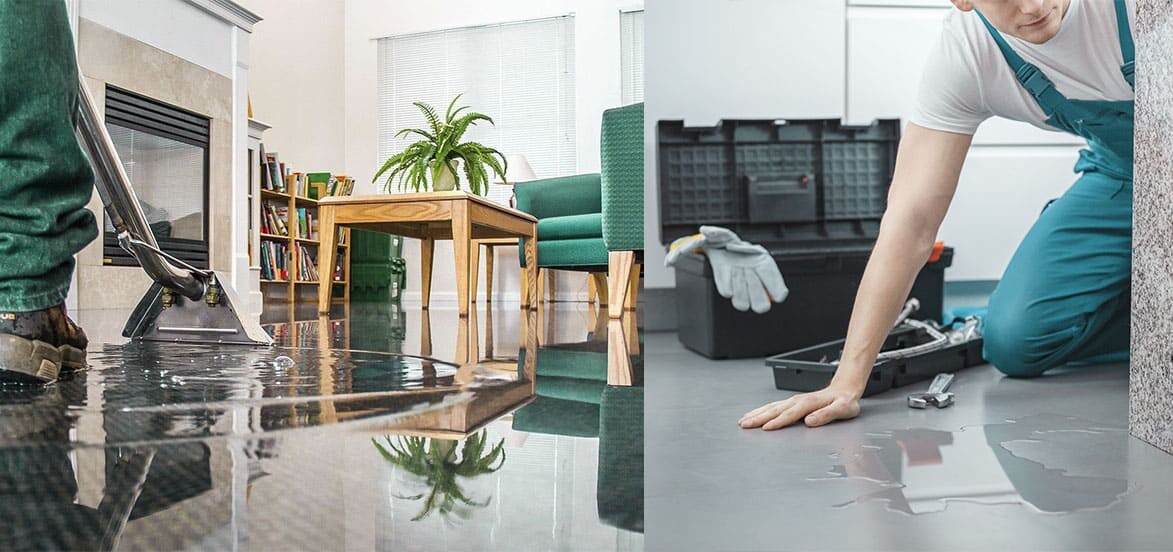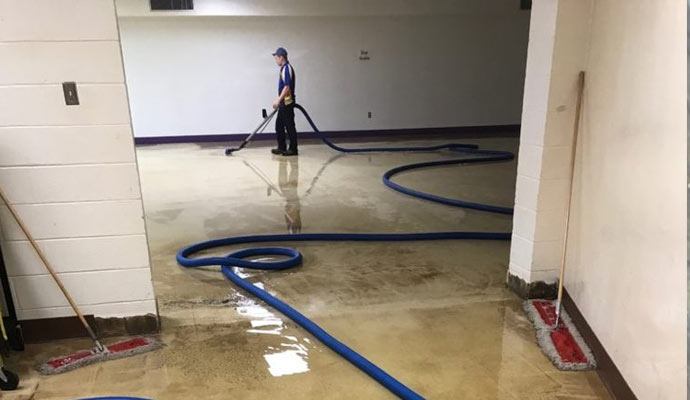Common mistakes to avoid when hiring Flood Cleanup Services
Leading Tips for Effective Water Damage Restoration: Protect Your Building Today
Water damage can strike all of a sudden, triggering significant disruption and prospective risks. Efficient restoration requires a methodical strategy to minimize additional damage. From assessing the damage to executing preventive actions, each step plays an important duty in guarding property. Comprehending these techniques can make all the difference in the aftermath of a water-related crisis. What necessary actions should be focused on to ensure detailed protection?
Analyze the Damage Immediately
When a water damage event happens, it is necessary to assess the damage instantly to alleviate further concerns. This first analysis assists figure out the level of the damage and recognizes affected locations. Water can leak into wall surfaces, floors, and furniture, resulting in mold development and architectural instability otherwise addressed without delay. A complete assessment should include looking for staining, wetness, and moldy odors, which indicate dampness visibility. It is additionally essential to record the damage via pictures and notes for insurance coverage objectives. Involving experts for a more comprehensive assessment may be essential, particularly when dealing with hidden or substantial damage. Water Damage Restoration. Early acknowledgment and exact assessment lay the structure for reliable restoration and guard the building from additional difficulties
Shut down the Water
Turning off the supply of water is a crucial action in avoiding further damage throughout a water-related incident. When a leakage or flooding happens, instant activity is vital to minimize the degree of the damage. Finding the main water shut-off shutoff should be a top priority. This shutoff is usually positioned near the water meter or where the water line goes into the building. As soon as situated, transforming the valve clockwise will certainly quit the flow of water. In cases where the major shutoff is unattainable, individual shut-off shutoffs for home appliances may also be made use of. Without delay turning off the water system not only safeguards the building from additional injury however also promotes the succeeding restoration process, making certain that recovery initiatives can begin without hold-up.
Eliminate Excess Water Quickly

Eliminating excess water without delay is important for lessening damage and preventing mold and mildew development in influenced locations. The longer water continues to be in contact with products such as drywall, wood, and insulation, the higher the risk of architectural damage and the development of mold and mildew. Water Damage Restoration. Homeowners ought to act promptly to evaluate the scenario and utilize proper tools, such as damp vacuum cleaners or pumps, to draw out standing water successfully. If the volume of water is substantial, getting in touch with specialist restoration solutions may be needed, as they can offer customized tools and experience. Furthermore, getting rid of furnishings and personal belongings from the damaged area can aid to lower damage and facilitate the general restoration procedure. Prompt activity not just safeguards home however likewise help in a smoother recovery journey
Dry Out the Affected Area
After eliminating excess water, it is vital to dry the damaged location completely. This includes eliminating any type of standing water and improving air blood circulation to promote dissipation. Efficient drying will assist protect against mold and mildew development and additional damage.

Remove Standing Water
Quickly resolving standing water is vital for effective water damage restoration. The existence of stagnant water can cause additional residential property damage and develop a setting helpful to mold development. To reduce these risks, it is necessary to get rid of standing water as promptly as feasible. This process typically entails making use of completely submersible pumps, damp vacuum cleaners, or specialized removal equipment. Professionals recommend assessing the depth and level of the water before choosing the proper technique for elimination. Security precautions should also be taken, consisting of using safety gear and making certain electricity is turned off in affected areas. As soon as the standing water is properly gotten rid of, the drying procedure can start, better securing the building from continuous damage.
Boost Air Blood Circulation
Increasing air circulation is necessary for properly drying areas influenced by water damage. This process aids to accelerate evaporation, minimizing the danger of mold and mold development. Experts often advise using fans to create a steady airflow throughout the area. Putting box fans in home windows can attract fresh air, while high-velocity fans can route airflow in the direction of moist surface areas. Flood Cleanup Services. In addition, opening up windows and doors permits cross-ventilation, enhancing the drying procedure. Dehumidifiers can likewise be employed to get rid of excess wetness from the air, further assisting in drying out. By making sure that air flows freely, residential property owners can substantially minimize the lasting impacts of water damage and safeguard the stability of their structure
Check for Mold Development
Mold development is a severe concern following water damage, as it can lead to health issues and structural deterioration. After any type of flooding or leaks, it is important to conduct an extensive evaluation of the influenced locations. This includes monitoring concealed areas such as behind walls, under this contact form carpets, and in cellars or attic rooms where dampness may linger. Indications of mold include a mildewy smell, discoloration on surfaces, or noticeable growth. Home owners ought to utilize protective gear when checking, as mold spores can pose health risks. If mold is identified, it is essential to resolve it promptly, as delaying remediation can exacerbate the issue and boost the risk of major wellness worries for occupants. Early treatment is crucial to effective mold management.

Repair Work and Restore Broken Structures
When resolving water damage, it is crucial to first analyze the architectural honesty of the influenced locations. This examination helps determine possible dangers and educates the required fixing strategies. Involving professional restoration solutions guarantees that the restoration process is performed securely and efficiently.
Analyze Structural Stability First
Prior to initiating any water damage restoration, it is important to examine the architectural stability of the damaged area. This assessment helps identify any kind of jeopardized elements, such as beam of lights, foundations, or wall surfaces, which might pose safety risks - Water Damage Restoration. Examining for indicators of bending, splitting, or mold and mildew development is essential, as these indications can reveal underlying damage that needs prompt focus. In addition, understanding the extent of the damage can assist restoration efforts and establish whether repair work are possible or if replacement is required. It is crucial to record findings thoroughly, as this information can be useful for insurance claims or future referral. Prioritizing structural assessment warranties that restoration initiatives continue securely and effectively, inevitably shielding the residential property and its owners
Usage Specialist Restoration Services
Utilizing specialist restoration services is crucial for efficiently repairing and recovering broken structures after water cases. These professionals have the essential training, tools, and experience to alleviate and examine water damage thoroughly. They can determine concealed problems, such as mold and mildew development and architectural weaknesses, that might not be immediately apparent. Professional services likewise use innovative drying techniques and devices, ensuring that all dampness is removed to avoid further damage. Furthermore, they follow industry standards and regulations, guaranteeing that the restoration procedure is efficient and risk-free. By involving restoration experts, home proprietors can accelerate recuperation, minimize lasting damage, and eventually protect their investment. This positive technique is necessary in preserving the stability and safety of damaged structures.
Prevent Future Water Damage
To efficiently avoid future water damage, property owners have to embrace an aggressive strategy to upkeep and repair services. Regular assessment of roofs, downspouts, and rain gutters is important; clogged rain gutters can lead to water overflow and roof covering leakages. In addition, looking for leakages in pipes fixtures and home appliances can prevent possible damage. Property owners ought to likewise take into consideration installing sump pumps in cellars or low-lying locations to take care of water accumulation. Sealing splits in structures and ensuring appropriate water drainage around the residential or commercial property are essential actions in safeguarding against water breach. Additionally, preserving humidity levels with dehumidifiers can avoid mold development. By applying these safety nets, home owners can substantially decrease the threat of water damage and secure their home for the long-term.
When a water damage event occurs, it is essential to examine the damage right away to reduce further problems (Water Damage Restoration). Eliminating excess water quickly is essential for reducing damage and preventing mold growth in impacted locations. Quickly dealing with standing water is important for reliable water damage restoration. The visibility of stationary water can lead to additional residential property damage and develop an environment favorable to mold growth. Prior to starting any kind of water damage restoration, it is vital to examine the structural integrity of the damaged area